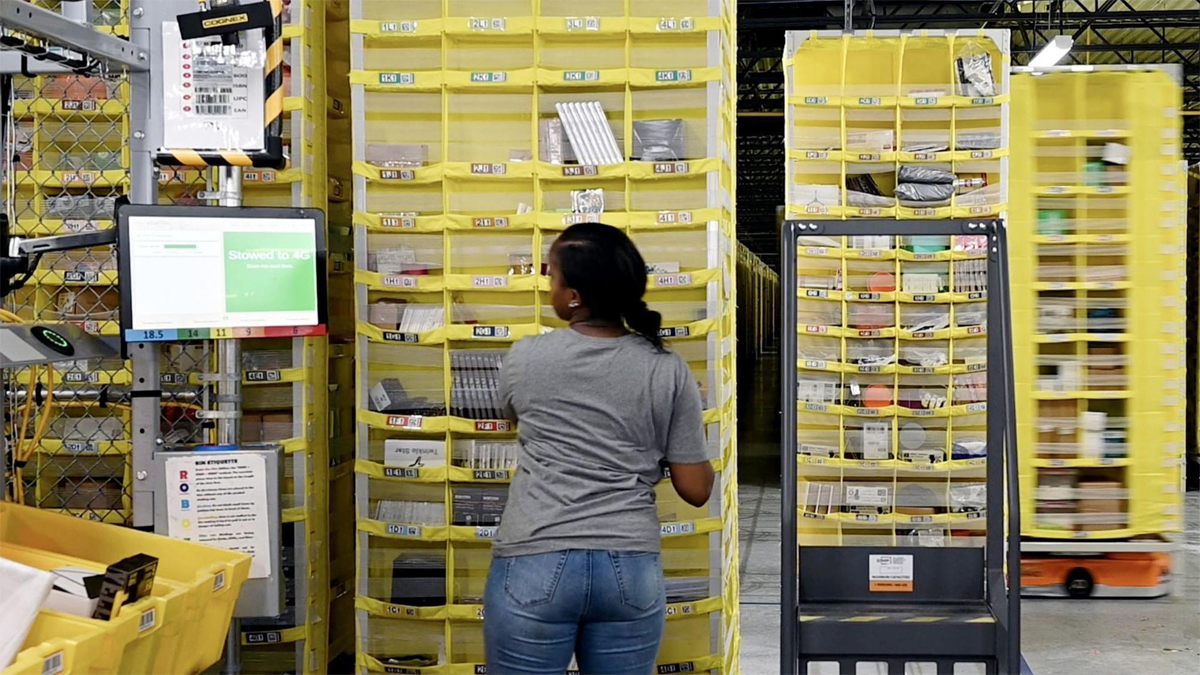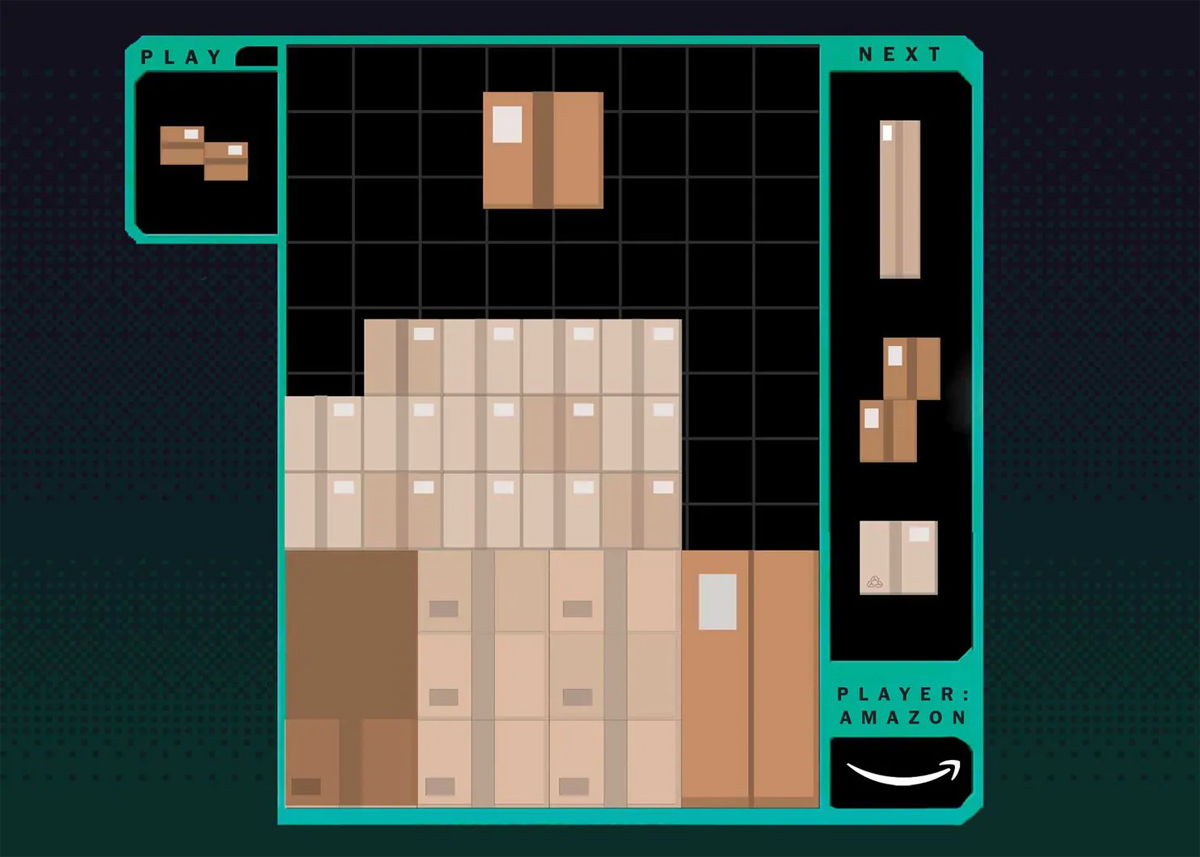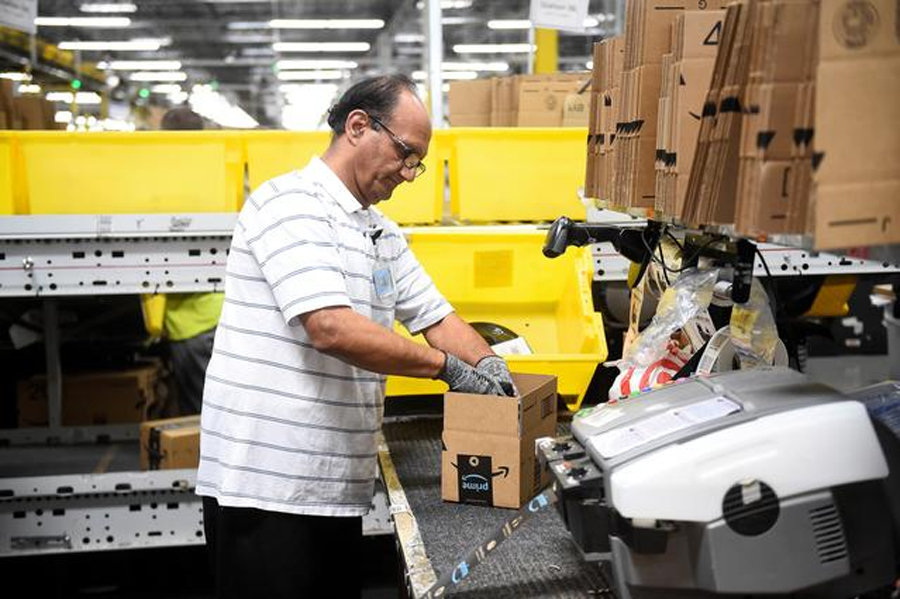
Labor at the warehouse is an extremely difficult and exhausting thing. Especially if you are required to get at least 300 goods per hour and travel 18 km per day. People organize protests, demand salary increases of at least $ 15 per hour, and turn to labor unions and senators.
How to make people work more actively in such conditions? We remove the increase in salaries outside the brackets - this is effective, but one of the most unpleasant methods for the company.
In order to somehow deal with the burnout of people (while not spending too much money), Amazon in some of its warehouses is testing work gamification. Hard work, following the precepts of Tom Sawyer, turn into a game.

Inside several huge cave-like Amazon warehouses, hundreds of workers hour after hour ... play. Someone is fighting virtual dragons or driving a Ferrari, someone is building castles, someone is just sitting in the Tetris. Moreover, for the victory they put quite real rewards, up to an increase in the hourly rate.
All of these games are actually a way to get people to fulfill customer orders even faster. The process is simply gamified, and progress is displayed in a game format. This is part of a retail giant experiment trying to lower the stress level of its employees. In theory, the introduction of such “achievements” will help the company increase labor efficiency, such as collecting the necessary goods on the shelves, carrying them, packing and placing them in trucks.
The program can be entered as desired. Thousands of “gatherers” and “packers” themselves choose what is best for them - work 10 hours a day, or turn part of a monotonous process into a game. Games are developed by the IT department of Amazon itself, and are displayed on small screens next to the employees ’workplace. There, in the form of something more ambitious (racing, tetris, mini-minecraft), the execution of everyday activities is shown. Tracking occurs, for example, with the help of a scanner , which in the warehouse “breaks through” each product when it is lifted.

People, teams or even entire floors compete with each other in the speed and scale of collection of items, the pace of packaging, the minimum number of errors. In the process, they get points, and prize-winners are awarded with money (in addition, they certainly will not be fired ). Also, of course, there are achievements ("Collected 20 items in 5 minutes!)" And various leaderboards. You can, for example, have nothing to do with setting yourself the goal of becoming a warehouse employee with the highest package packing speed.
Our whole life
It’s not just Amazon that is disguising labor as a game. Her experiment is part of the great emphasis on gamification that is now taking place with large American companies. They understand that often one financial instrument is not enough, a person wants to feel that he is doing something special, and that his work is noticeable. For employees who are engaged in not very prestigious, low-skilled work, special software is created that allows them to at least slightly entertain themselves in the process.

This is most successfully implemented by Uber and Lyft. Their drivers can compete with each other and perform peculiar “achievements” in order to receive an additional fee. For example, you need to make 60 trips per week or drive 40 kilometers a day. Why not "kill 10 mobs" or "go to deliver the item"? Such quests in the real world are designed to help drivers stay on the roads longer. If you have five kilometers left until you receive a bonus, even a virtual one, it becomes a little more difficult to force yourself to leave work.
A similar system today is implemented by the most successful food delivery services in the United States. Their couriers have not been satisfied with just an hourly payment or a bonus for the successful completion of an order. But ten orders a day, delivery in less than 10 minutes, or top-1 in terms of deliveries per week in your area of the city - this is already interesting! Many are happy to buy this, especially the younger generation. Achievements and leaderboards, and even with financial prizes? Give me two!

Target uses games to encourage cashiers - so they scan products faster. In landfills, some management companies have been using the Tetris version to force employees to pack garbage more tightly for more than ten years. Perhaps Amazon spied on the idea for boxes from there. And some IT firms reward their people for achieving certain successes in training (three hours of a gym a week, losing 10 kg of weight, etc.). Over time, this approach can reduce the company's costs of insurance and sick leave.
Most often, gamification disguises the most common (but boring) performance goals. In the format of the game, all this does not become so obvious as just an “employee of the month”. In a call center, for example, to receive a gold star in one day, you will need to answer 20 customer requests. In the other - three times to get five points from them. The third is to help the client in less than two minutes, and also get the top five. The employee did not immediately realize that on the first day the program recorded too many calls, and on the second - the company wanted to check the implementation of the rating system. Moreover, the numbers of the “game” can be modified according to the situation. Sometimes it makes sense to tighten the level of difficulty, sometimes, if there are few customers, you can remove achievements at all.
Gabe Siekermann , who advises companies on gamification issues and has written three books on this topic, says the system is best at performing “frankly boring” tasks. If you do not fulfill his desire at all, if the routine is sucked in, turning the process into a game can be effective. Burnout is reduced. Siekermann especially advises this system to companies facing high staff turnover.
At the same time, if one focuses specifically on the spirit of rivalry and leaderboards (a la five-year plan in the USSR), he says, a good effect is observed only for a few months. Further, an employee who actively fought for a “place in the top”, on the contrary, begins to feel squeezed and loses interest. And those of his colleagues who regularly lose in the races, especially since they do not feel any positive emotions about them. Therefore, the type of "carrot" must be alternated. Set a person’s personal goals. And, ideally, to introduce technology only at the moment of emergency.
Amazon has so far added video games to ten stores in the US and Britain. Different warehouses are specially selected. From huge with thousands of employees to the smallest and lamp ones. It is checked under what conditions the games give the best effect.

Trying to increase the morale and productivity of employees through games, the company hopes to lose its reputation as a "greedy exploiter." Last year, she got a lot from Senators Bernie Sanders and Elizabeth Warren. Like, the conditions in the warehouses are too cruel and inhumane, and wages barely cover basic human needs, despite the fact that Bezos is getting richer. Now both of these senators are running for president.
If employees continue to complain to reporters, and public opinion is not in Bezos’s favor, politicians are likely to make Amazon's job more difficult soon, and it could cost her hundreds of billions. Therefore, it is necessary to somehow change the situation, and urgently. For some people, the “game of work” is a much better motivator than a small salary increase. Which means why not.
results
We wrote an article about Amazon’s warehouses on Habré (then Giktimes) an article two years ago. And even since then, much has changed. For example, if earlier robots were in the minority, now they are in almost every location. The right shelf is brought directly to the person, and it remains to choose those items that are needed in the order. There are no shelves with a specific type of goods, everything is located randomly, so that the right thing is always nearby. Where everything is located, only robots and scanners, pistols with displays, which everyone has in their hand, know.

The monotony and primitiveness of the work, as a result, increases. You do not need to engage in thought processes, all the decisions have already been made by I.I. And you are just a hand that just costs so far less than the same mechanical one.
Loads also increased. Previously, employees were required to raise 100 goods from shelves per hour, but now it is already 300-400 goods per hour (fewer on Mondays and Thursdays, more in the evening and on holidays). There is no time for communication or rest, from entertainment - only the annoying picking of a scanner, reminding you to quickly go and take the next item.
Workers on condition of anonymity tell publications that games help add a little bit of variety. One employee said she was able to pick up as many as 500 things per hour. Each thing was a point on the racetrack, and it competed with other workers whose car would reach the finish line faster.
The games are different, and they are enough to make the day go faster. There are races, "Duel of Dragons", "Castle Construction", "Space Adventure". Everyone has super-simple graphics that even games from the early 90s would be shy of. But their idea is instantly understandable, and the results are visible even from the small screen of the scanner. Since this is a test, and the technology that Amazon is counting on in the fight against other retailers, the company does not provide screenshots of the games. Employees are also forbidden to remove them, and generally carry smartphones or cameras indoors.
For winning games, people usually get virtual dollars, which can be exchanged for stickers, t-shirts, caps or cups with the Amazon logo. Sometimes, at least once a week, winners are given real gift cards for which you can buy anything on the site. Most often, as a result, this thing will be delivered to their house from the same warehouse.
